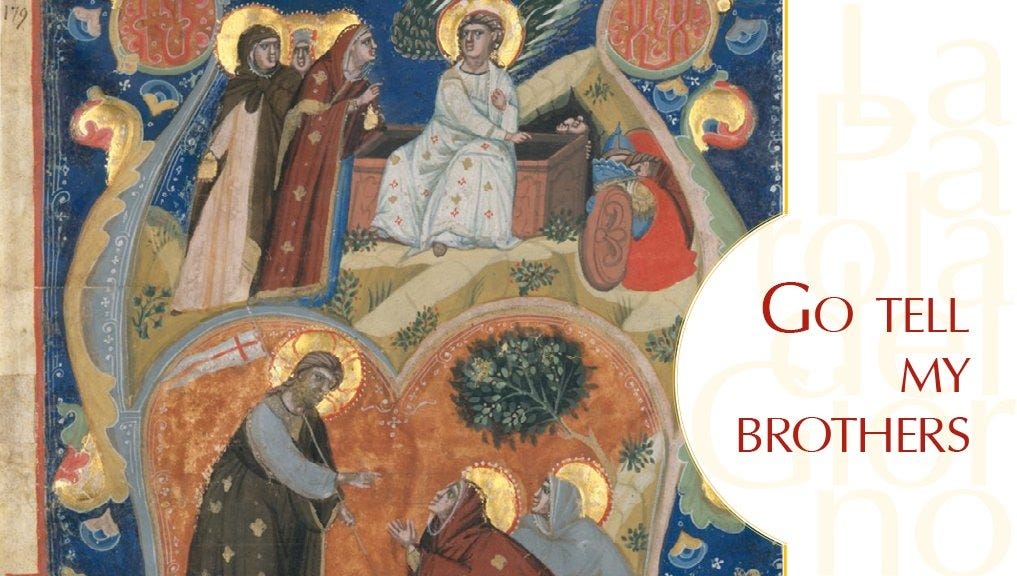8 And they departed quickly from the tomb, in fear and great joy, and ran to tell his disciples. 9 And behold, Jesus met them saying, “Hail!” And they came up and embraced his feet and worshipped him. 10 Then Jesus said to them, “Do not be afraid. Go take word to my brethren that they are to set out for Galilee; there they shall see me.” 11 Now while they were going, behold, some of the guard came into the city and reported to the chief priests all that had happened. 12 And when they had assembled with the elders, and had consulted together, they gave much money to the soldiers, 13 telling them, “Say, ‘His disciples came by night and stole him while we were sleeping.’ 14 And if the procurator hears of this, we will persuade him and keep you out of trouble.” 15 And they took the money and did as they were instructed; and this story has been spread abroad among the Jews even to the present day. (Mt 28:8-15 NCE)
A referencing of a few previous verses to this Gospel passage is helpful to apprehend a slightly bigger picture. The “they” referred to in verse 8 of this Gospel passage of Matthew was referring to Mary Magdalene and “the other Mary,” the women at the grave in the beginning of this chapter. But as this chapter also says, there were also guards present, and an “angel of the Lord.” And both the guards and the women witnessed something—not the actual witnessing of the Resurrection itself—but the revealing of the empty tomb. The angel of the Lord, however, did not speak to the guards who were “terrified and became like dead men,” (Mt 28:4) but rather spoke consolingly to the faithful women, saying, “Do not be afraid; for I know that you seek Jesus, who was crucified. He is not here, for he has risen even as he said. Come see the place where the Lord was laid.” (Mt 28:5-6)
But this Gospel begins with the women upon their leaving the tomb, encountering our risen Lord. They were, in fact, the first to see Him—before any of the disciples! Christ greeted them, giving them instructions, saying, “Hail! Do not be afraid. Go take word to my brethren that they are to set out for Galilee; there they shall see me.” (Mt 28:9-10) And while the women were experiencing the awe and wonder being at the feet in worship of Christ, anxious to tell the disciples, the guards were off telling their bosses what they had seen. Perhaps in some respect the guards were at least honorable enough to instinctively want to tell the truth, but that was quickly dispelled with a monetary offering to change their story to one of grave robbery.
Women close to Jesus in those times certainly held a special place with Him. And although they weren’t considered as official Apostles (theological reasons, e.g. male priesthood, etc.), they nonetheless were held dear to Christ in many other ways. This is one example, that both Mary’s, having the privilege of being the first to see the risen Lord would undoubtedly denote a special trust and closeness between them. They may even be a typology of our Blessed Mother, foreshadowing the unique place that Christ’s mother holds in His heart.
This Gospel importantly displays deep faith in action vs. deep denial. As seen, God indeed knew the disposition of the women’s souls, just as he knew the disposition of the guards and the Pharisee’s. The women, previously quelled by the angel, left with a healthy fear of the Lord to joyfully proclaim the good news of His resurrection to the disciples. For these women, who were crying at the foot of the Cross during our Lord’s crucifixion, not only knew where Jesus was to be buried, but had still followed our Lord all the way to the grave and beyond! And God knew of their faithfulness, their hope, their conviction, their love—their hope fulfilled in their great faith. On the other hand, the guards, although seeing an empty tomb and an angel, but not Christ, had even their own senses denied by the Chief Priest’s out of fear, hatred and the fact that they could not abide any narrative but their own. Sound familiar?
In a hardened world, a stone sealing up a grave may indeed seem like a finality. Harsh and lifeless adherence to the law for the sake of the law had enclosed the Jewish religious hierarchy in their own tombs, from which, unbeknownst to them, only Jesus could release them. Upon knowing in faith that Christ rose from the empty tomb, Christ subsequently made Himself visible to the women by the virtue of their belief, their hope and their love. So, we are reminded to look beyond the idea of worldly salvation with ends in the grave, and rather cultivate God’s gift of faith, praying that we increase in virtue to better see our risen Lord. As we reflect on this Gospel passage, let us meditate on the same joy as the women had, and not be afraid to profess what is true as we remember that sin and death are never a finality when one knows Christ has risen!



https://substack.com/@poetpastor/note/p-161754022?r=5gejob&utm_medium=ios&utm_source=notes-share-action